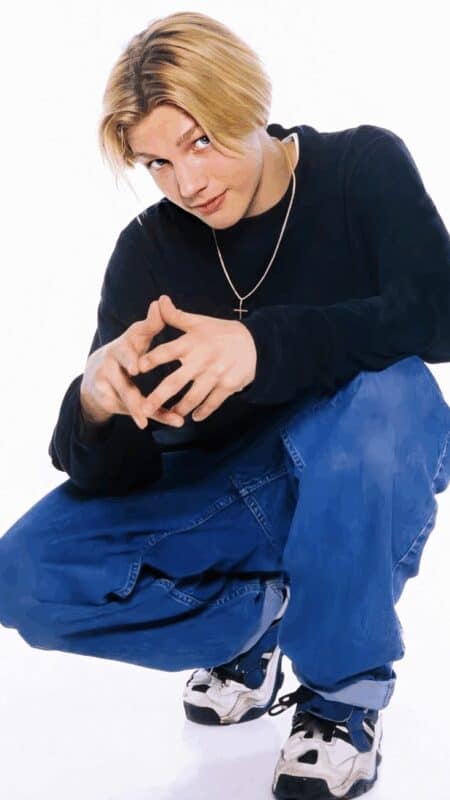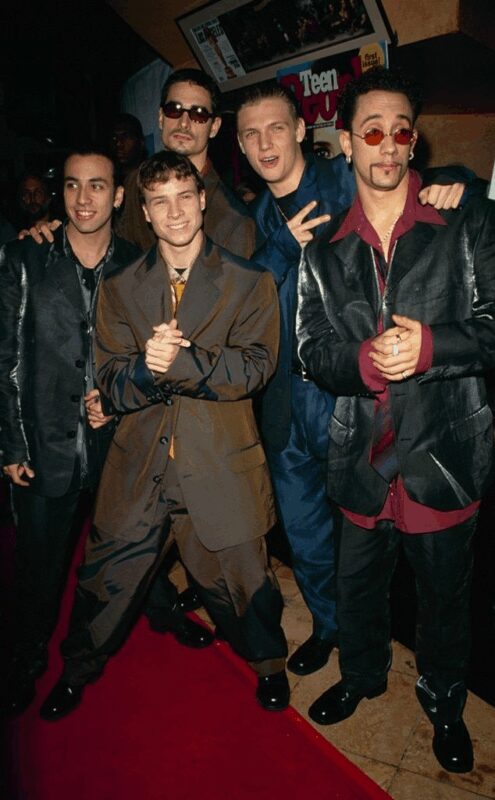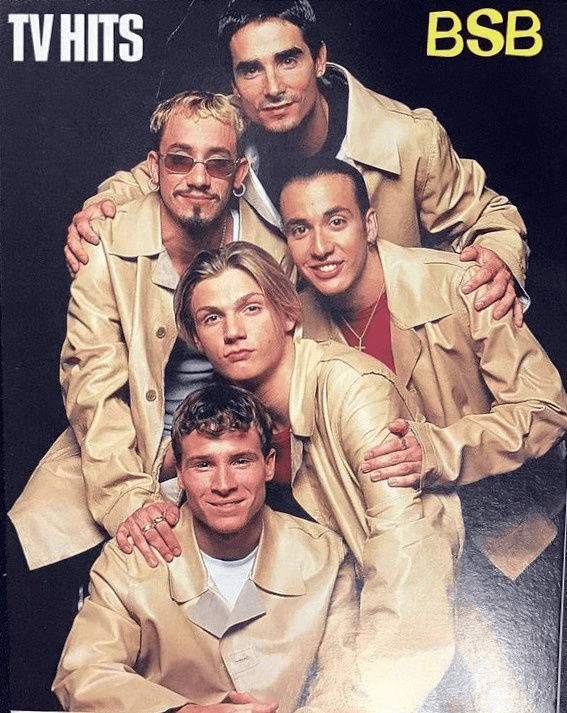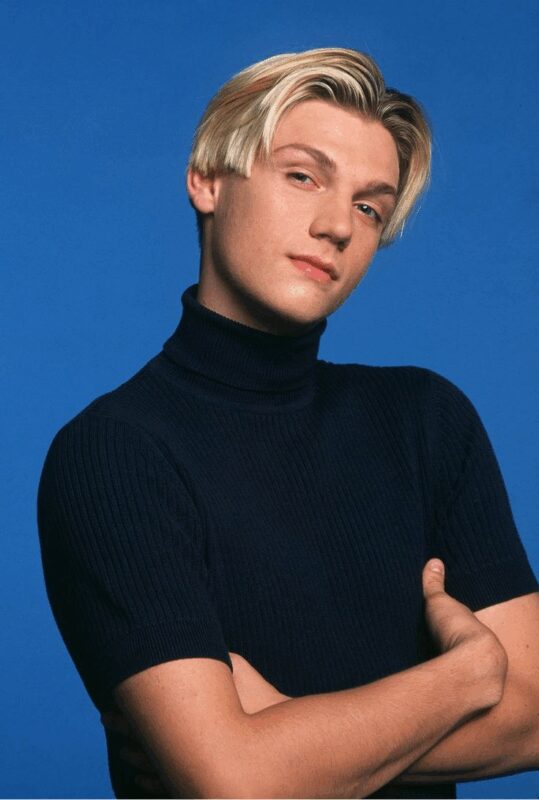Nick Carter didn’t just top the charts—he defined a decade of style. Synonymous with the Nick Carter 90s look, his iconic hairstyle—those perfectly parted blonde curtains—became a symbol of teen pop cool and set the standard for boy band fashion .
As the Backstreet Boys rose to global fame, Carter’s look helped shape the era’s grooming trends, inspiring millions of fans to imitate his hair. Decades later, that signature style still sparks nostalgia—and continues to find new life in today’s fashion cycles.
Let’s take a closer look at how one haircut became a cultural moment.
Key Takeaways
-
Nick Carter’s 90s hairstyle became an iconic cultural symbol, defining teen pop fashion of the era and influencing millions of fans and fellow celebrities.
-
His evolving look reflects broader shifts in personal style and pop culture, moving from boy band heartthrob to a more mature and individual image throughout his solo career.
-
The Backstreet Boys played a major role in shaping 90s fashion trends, with coordinated styles and distinct personalities that left a lasting impression on pop culture.
-
A resurgence of 90s nostalgia has revived interest in Carter’s signature style, as modern fashion trends and social media revisit the curtain haircut and other era-defining looks.
The Evolution of Nick Carter’s Hairstyle

Credits: @carterealm / Pinterest
Nick Carter’s hairstyle has evolved over the years, reflecting both personal growth and shifting fashion trends. From his early days with the Backstreet Boys to his current look, Carter’s hair journey mirrors the evolution of pop culture and personal style.
Early Years: The Iconic ‘Curtain’ Hairstyle
In the late 1990s, Nick Carter’s signature look featured the ‘curtain’ hairstyle—blonde locks parted down the middle, framing his youthful face. This style became emblematic of the era, with fans and fellow celebrities alike adopting the look.
The ‘curtain’ haircut wasn’t just a fashion statement—it was a cultural phenomenon that defined a generation’s aesthetic.
Peak Popularity: A Symbol of 90s Pop Culture

Source: eonline.com
As the Backstreet Boys soared to international fame, Carter’s hairstyle remained a constant—even as fashion trends evolved. His hair became synonymous with the band’s image, helping to cement their identity as pop icons.
The consistency of his look during this era reinforced his status as both a teen heartthrob and a style influencer.
Modern Day: Embracing Change
In recent years, Nick Carter has experimented with various hairstyles, moving away from his iconic ‘curtain’ look. He’s been seen sporting shorter cuts—including buzz cuts and textured styles—that reflect a more mature and contemporary image.
These changes signify both personal and artistic evolution, aligning with his ongoing career in music and entertainment.
Nick Carter’s hair journey illustrates the interplay between personal expression and cultural trends.
From defining a generation’s style to adapting through different life stages, his hairstyles have been more than fashion choices—they’ve served as markers of his enduring presence in the music industry and popular culture.
The Backstreet Boys’ Impact on 90s Fashion
The Backstreet Boys didn’t just dominate the music charts in the 90s; they also set significant fashion trends that left a lasting impression.
Group Dynamics

Credits: @nana5bsb / Pinterest
Each member of the Backstreet Boys brought a unique style that contributed to the group’s cohesive image:
- Nick Carter’s youthful and approachable look
- AJ McLean’s edgy and bold fashion choices
- Kevin Richardson’s classic and mature style
- Howie Dorough’s sleek and polished appearance
- Brian Littrell’s casual and athletic vibe
Together, these styles created a diverse yet harmonious ensemble. This blend allowed fans to connect with individual members while appreciating the group’s overall aesthetic.
Fashion Trends
It wasn’t just their hairstyles—the Backstreet Boys also popularized several fashion trends in the ’90s that became synonymous with the era. They often wore coordinated outfits, including matching denim ensembles, oversized sports jerseys, and monochromatic color schemes.
The result? They set the standard for boy band fashion. Accessories like bandanas, leather jackets, and tinted sunglasses further defined their look. These styles were widely imitated by fans and helped influence mainstream fashion during that time.
Legacy
The influence of the Backstreet Boys’ ’90s fashion is still evident today. Current fashion trends often revisit and reinterpret styles from that era, with modern artists and fashion enthusiasts drawing inspiration from the group’s iconic looks.
The resurgence of ’90s fashion in contemporary culture underscores the lasting impact of the Backstreet Boys’ style on the fashion industry.
Reflecting on their fashion legacy, it’s clear that the Backstreet Boys played a pivotal role in shaping ’90s fashion trends. Their ability to blend individual styles into a cohesive group image not only enhanced their appeal but also left an indelible mark on the fashion world.
Nick Carter’s Solo Career and Its Influence

Credits: @gokendall / Pinterest
After years with the Backstreet Boys, Nick Carter ventured into a solo career, marking a new chapter in his musical journey. In 2002, he released his debut solo album, Now or Never, which featured a distinct pop-rock sound that set it apart from the group’s signature style.
The album debuted at number 17 on the Billboard 200 and was certified gold in the U.S., Canada, and Japan.
Carter continued to explore his musical identity with subsequent releases. In 2011, he released I’m Taking Off, which found success in Japan, peaking at number 8 on the Oricon Albums Chart.
His 2015 album, All American, included collaborations with artists like Avril Lavigne, further diversifying his musical repertoire.
Throughout his solo projects, Carter’s fashion evolved to reflect his personal growth and the changing music landscape.
Moving away from the coordinated outfits of his boy band days, he adopted a more mature and individualistic style—often appearing in casual yet polished attire during performances and public appearances.
Carter’s solo career not only showcased his artistic versatility but also helped redefine his personal brand, highlighting his ability to adapt and remain relevant in the ever-evolving music industry.
The Resurgence of 90s Hairstyles

Source: regalgentleman.com
Carter’s solo career showed he could stand on his own, but what I find just as interesting is how his early image—especially that iconic ’90s hair—refuses to fade away.
These days, I can’t scroll through social media without seeing some version of the curtain hairstyle popping up again. It’s not just people reminiscing—it’s a full-on comeback.
There’s no question that ’90s nostalgia is everywhere—from music to movies to fashion—and hair is no exception.
Styles like the Topanga Hair—those soft, face-framing layers—are all over TikTok and Pinterest, with people asking how to achieve that volume-heavy, carefree look.
Another style that’s exploded lately is the classic 90s blowout, with a big, bouncy texture—something I’ve seen recreated not just by influencers but also by public figures like Sabrina Carpenter and Kylie Jenner.
Much of this resurgence is tied to the renewed popularity of ’90s pop icons. Nick Carter, the Backstreet Boys singer and youngest member of the group, remains one of the biggest symbols of that decade.
His early look—blonde curtain bangs and that clean boy-next-door vibe—still appears in throwback posts on social media and fan edits from the era of their self-titled debut album.
Events like 90s Con bring this energy full circle. Attendees wear vintage outfits, recreate old music video styles, and celebrate artists like Carter, Justin Timberlake, and Britney Spears—many of whom launched their careers through platforms like the Mickey Mouse Club.
These icons didn’t just shape music; they defined a generation’s look.
Even those who grew up watching the Backstreet Boys, or following the documented history of their manager Lou Pearlman, find themselves revisiting those styles.
Some of this nostalgia is bittersweet—especially when remembering the public struggles faced by the Carter family.
But the fashion side? That’s pure ’90s gold. And now it’s back, reimagined by a new generation—from Los Angeles runways to everyday TikTok routines. Whether you’re discovering these trends for the first time or revisiting them, the ’90s curtain cut still fits right in.
DIY Tips: How to Get the Nick Carter Look Today

Credits: @bsbspanisharmyclub / Pinterest
If you’re thinking about bringing that hairstyle back (and honestly, why not?), it’s easier than you might expect. Nick Carter’s classic curtain cut wasn’t just a trend—it became part of his personal brand, influencing fans around the world.
As part of the best-selling boy band of all time, Carter’s look helped define the 90s aesthetic. Even during his solo albums and appearances on shows like The Masked Singer, that image remained part of his identity.
Here’s how to recreate the look today:
- Haircut: Ask your barber for medium-length layers that hit right around the cheekbones. This is key to getting the part to fall naturally in the center. The shape should frame your face without being too thick or weighed down.
- Style Tools: Use a blow dryer and round brush. The goal is to build volume at the roots while curving the front layers away from the face. This helps recreate that slightly windswept but controlled 90s flow Nick made famous.
- Product: Use a light-hold mousse or styling cream. Carter’s style always had movement—it wasn’t overly stiff or gelled. A soft texture will help you achieve the same feel as the album art from his Now or Never era, where his image became just as recognizable as his vocal talents.
- Maintenance: This look requires a bit of upkeep, especially if your hair is naturally thick or wavy. A dry shampoo can help refresh the roots without flattening them. If your hair tends to lose shape, a quick heat touch-up with a round brush can bring it back to form.
The look works especially well for straight or slightly wavy hair. It’s casual enough for everyday wear but can be styled more cleanly for events—even something formal in New York, where fashion-forward looks are a must.
Fans still share clips of Nick from live performances and music videos, especially ones tied to his new album. The best? Many are still praising not only his style but the feel of the album and the “deep connection” they sense in his latest work.
While his public image has faced challenges—including ongoing legal issues, such as the alleged assault claims by Melissa Schuman and Shannon Ruth, covered in recent court documents and updates involving a restraining order—his style legacy remains strong.
Whether you admired Nick for his hair, his fashion, or his music, this 90s look carries nostalgia with it—and it’s surprisingly wearable in 2025.
If you’re styling it for the first time, be patient. It might take a few tries to get it right, but once you do, it feels like a “perfect song”—a look that clicks and stays with you.
Conclusion: Nick Carter’s Timeless Style
Nick Carter’s 90s hairstyle remains one of the most iconic looks in pop culture. That center-parted curtain cut helped define the boy band era and became a signature of the Backstreet Boys singer during the peak of their music career.
Decades later, his style still inspires new trends and nostalgic revivals. Whether through social media, fashion throwbacks, or modern updates, Carter’s look continues to influence—and remind us why he’s considered a true 90s fashion icon.
In a world where trends shift fast, that kind of staying power speaks volumes. His style was never just about hair—it was about confidence, identity, and connection. And that’s why it still matters.
